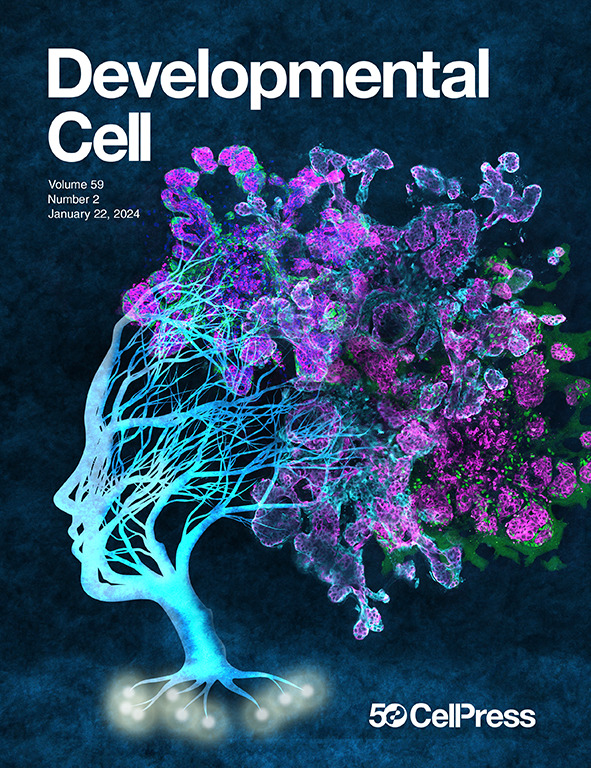stat3控制的CHI3L1/SPP1正反馈回路显示了胶质母细胞瘤的空间异质性和免疫特性
IF 8.7
1区 生物学
Q1 CELL BIOLOGY
引用次数: 0
摘要
前神经-间充质转化(PMT)是一种表型改变,有助于胶质母细胞瘤(GBM)的恶性进展。巨噬细胞作为肿瘤免疫微环境(TIM)的主要浸润成分,控制PMT的生物学过程;然而,驱动这一过程的机制在很大程度上仍然未知。在这里,肿瘤和非肿瘤细胞的整体景观是用scMulti-omics技术描述的。然后,我们利用源自PN20细胞的C57BL/6和NSG小鼠模型证明了几次质酶-3样蛋白1 (CHI3L1)在维持间充质(MES)状态和巨噬细胞表型重编程中发挥了关键作用。在机制上,骨桥蛋白(OPN)/ITGB1通过与CHI3L1-STAT3轴建立正反馈回路,维持核因子κB (NF-κB)和转录信号转导因子3 (STAT3)通路的激活,从而导致PMT。CHI3L1通过直接结合STAT3的coil -coil结构域(CCD),增强了STAT3的磷酸化、核定位和转录活性。重要的是,我们筛选并验证了湿霉素B (HB), STAT3-CCD结构域的抑制剂,破坏CHI3L1-STAT3相互作用,从而在体外和体内减少肿瘤负担。本文章由计算机程序翻译,如有差异,请以英文原文为准。

STAT3-controlled CHI3L1/SPP1 positive feedback loop demonstrates the spatial heterogeneity and immune characteristics of glioblastoma
Proneural-mesenchymal transition (PMT) is a phenotypic alteration and contributes to the malignant progression of glioblastoma (GBM). Macrophages, as a main infiltrating component of the tumor immune microenvironment (TIM), control the biological processes of PMT; however, the mechanisms driving this process remain largely unknown. Here, the overall landscape of tumor and nontumor cells was described by scMulti-omics technology. Then, we demonstrated that chitinase-3-like protein 1 (CHI3L1) played a critical role in maintaining mesenchymal (MES) status and reprogramming macrophage phenotype using C57BL/6 and NSG mice models derived from PN20 cells. Mechanistically, osteopontin (OPN)/ITGB1 maintained the activation of nuclear factor κB (NF-κB) and signal transducer and activator of transcription 3 (STAT3) pathways by establishing a positive feedback loop with the CHI3L1-STAT3 axis, resulting in PMT. CHI3L1 enhanced the phosphorylation, nuclear localization, and transcriptional activity of STAT3 via directly binding its coiled-coil domain (CCD). Importantly, we screened and validated that hygromycin B (HB), an inhibitor of the STAT3-CCD domain, disrupted the CHI3L1-STAT3 interaction, thereby reducing the tumor burden in vitro and in vivo.
求助全文
通过发布文献求助,成功后即可免费获取论文全文。
去求助
来源期刊

Developmental cell
生物-发育生物学
CiteScore
18.90
自引率
1.70%
发文量
203
审稿时长
3-6 weeks
期刊介绍:
Developmental Cell, established in 2001, is a comprehensive journal that explores a wide range of topics in cell and developmental biology. Our publication encompasses work across various disciplines within biology, with a particular emphasis on investigating the intersections between cell biology, developmental biology, and other related fields. Our primary objective is to present research conducted through a cell biological perspective, addressing the essential mechanisms governing cell function, cellular interactions, and responses to the environment. Moreover, we focus on understanding the collective behavior of cells, culminating in the formation of tissues, organs, and whole organisms, while also investigating the consequences of any malfunctions in these intricate processes.
 求助内容:
求助内容: 应助结果提醒方式:
应助结果提醒方式:


